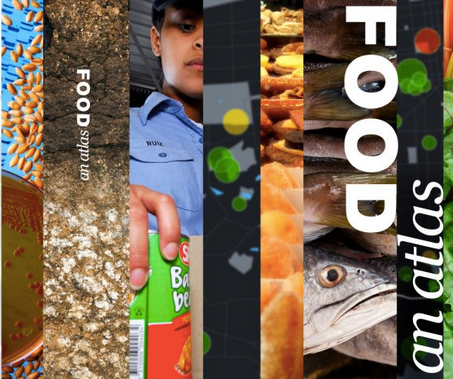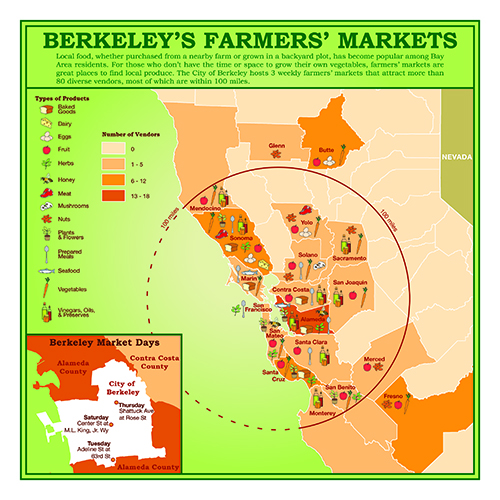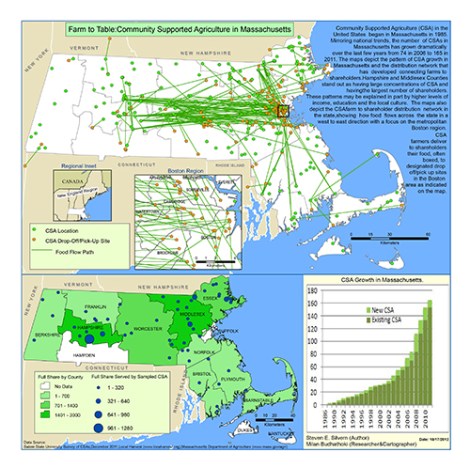Do you ever wonder how many vendors at your local farmers market are really local?
Cameron Reed did. So she mapped them for a school project. As she expected, the vast majority — more than 80 percent — did indeed come from within 100 miles, but Reed was surprised to find that a wide mix of products were grown and produced even closer to home — within 50 miles of where she lived.
An updated version of the map Reed made will appear in an upcoming collection called Food: An Atlas, which will chart the world of food in some of its most inspiring and somber dimensions — from food production, distribution, and food security to cuisine. Like many of those behind the atlas, Reed hopes to inspire people to think more closely about the origins of their food.
“It’s a book about the geography of food,” says Darin Jensen, a University of California at Berkeley professor and cartographer who is spearheading the project. Jensen issued a call for maps in June and the submissions began pouring in. Food: An Atlas is crowdsourced from roughly 100 volunteers spread across parts of the globe, including a loose band of what Jensen calls “guerrilla cartographers.” That means they created maps and contributed to the project voluntarily, not because they are under assignment.
You can also call Jensen a guerrilla publisher. He will take a non-traditional approach and self-publish Food: An Atlas, courtesy of a Kickstarter campaign that ends Tuesday. (As of last week, it had already hit its $20,000 goal, as well as additional $1,500 to create a website for the project and release it as an e-book.)
The $20,000 will be used to print the first 1,100 copies. The balance will go to print additional copies and toward sales and distribution, which will begin in early December.
Some maps, such as one of a tomato tour of Europe, raise interesting questions about global trade. Spain, for example, exports some of its best tomatoes out of the country at a premium, according to author Lucia Argüelles of Barcelona, but it also imports tomatoes for consumption from other nations, such as Morocco and France, or from the Netherlands during the winter. These inefficiencies exacerbate environmental problems, such as climate change and air pollution.
Several maps look to the past, such as the one that examines how the vast agricultural landscape of Los Angeles County has largely disappeared over the last 70 years. There is also a series of six maps that depict worldwide agricultural land use every 50 years from 1700. Taken together, the maps show an incredible intensification of agriculture in areas such as North America, Russia, and Europe.
Even with this huge expansion and intensification of agriculture around the world — in many places we’re pretty close to our agricultural limits — there are still several pristine areas that haven’t been used for farming, says cartographer Bill Rankin, referring to undeveloped regions in the Amazon, Congo, and Southeast Asia.
“We already know the rainforests are areas of key concern, but I really think the maps underscore the kinds of pressure they’re facing, and the pressures are agricultural,” says Rankin, a professor of science history at Yale.
Other maps in the collection are downright sobering, such as one that outlines the farmers markets in large U.S. metro areas, with an overlay of the number that accept food stamps, which is smaller than what Jensen would like to see.
“There are a lot of farmers markets — the Northeast and West Coast have an abundance — but that food is mostly available to people who can pay cash dollars, and farmers markets aren’t cheap anymore,” Jensen says. “We’re withholding accessibility to fresh, often organic produce, from the people who sometimes need it the most.”
There are also maps for children and a chapter focused on conceptual maps. And some maps are designed to bring out your inner food nerd, particularly in the cuisine section. For example, there is Meatpaper magazine’s map that takes you on a journey of the world’s familiar and exotic national dishes, which include Peking duck in China, poutine in Canada, ceviche in Peru, and the hamburger in the U.S.
Another calls out all the community supported agriculture (CSA) and community supported fishery programs in Massachusetts (i.e. the food delivery programs dedicated to supporting small farms and fishermen).
And who wouldn’t be interested in a map of the U.S. “beer shed,” which plots the dominant regions for growing the ingredients used to make most beers? If you live in Oakland, a map of the taco trucks in that area would probably come in very handy.
Jensen plans to take Kickstarter donors who have given generously to the project on a tour of those same taco trucks with the core team behind Food: An Atlas. Backers may also receive a copy of the book, other dining rewards, he says, and, of course, the chance “to be counted among the guerrillas.”






